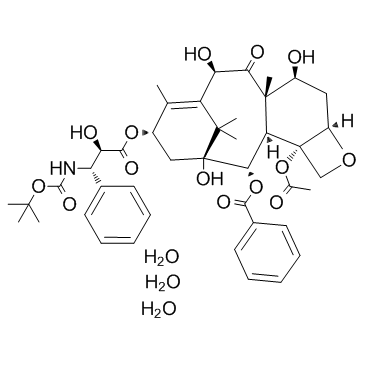148408-66-6
| Name | docetaxel trihydrate |
|---|---|
| Synonyms |
Xrp6976
Benzenepropanoic acid, β-[[(1,1-dimethylethoxy)carbonyl]amino]-α-hydroxy-, (2aR,4S,4aS,6R,9S,11S,12S,12aR,12bS)-12b-(acetyloxy)-12-(benzoyloxy)-2a,3,4,4a,5,6,9,10,11,12,12a,12b-dodecahydro-4,6, 11-trihydroxy-4a,8,13,13-tetramethyl-5-oxo-7,11-methano-1H-cyclodeca[3,4]benz[1,2-b]oxet-9-yl ester, (αR,βS)-, hydrate (1:3) Unii-15H5577cqd (2α,5β,7β,10β,13α)-4-Acetoxy-1,7,10-trihydroxy-13-{[(2R,3S)-2-hydroxy-3-({[(2-methyl-2-propanyl)oxy]carbonyl}amino)-3-phenylpropanoyl]oxy}-9-oxo-5,20-epoxytax-11-en-2-yl benzoate trih 
ydrate docetaxel trihydrate DOCETAXEL HYDRATE (1β,2α,5β,7β,10β,13α)-4-Acetoxy-1,7,10-trihydroxy-13-{[(2R,3S)-2-hydroxy-3-({[(2-methyl-2-propanyl)oxy]carbonyl}amino)-3-phenylpropanoyl]oxy}-9-oxo-5,20-epoxytax-11-en-2-yl benzoat e trihydrate Benzenepropanoic acid, β-[[(1,1-dimethylethoxy)carbonyl]amino]-α-hydroxy-, (2aR,4S,4aS,6R,9S,11R,12S,12aR,12bS)-12b-(acetyloxy)-12-(benzoyloxy)-2a,3,4,4a,5,6,9,10,11,12,12a,12b-dodecahydro-4,6, 11-trihydroxy-4a,8,13,13-tetramethyl-5-oxo-7,11-methano-1H-cyclodeca[3,4]benz[1,2-b]oxet-9-yl ester, (αR,βS)-, hydrate (1:3) Docetaxel (Trihydrate) |
| Description | Docetaxel Trihydrate is a semi-synthetic taxane analogue, acts as a microtubule stabilizer. |
|---|---|
| Related Catalog | |
| Target |
Microtubule[1] |
| In Vitro | Docetaxel (DOC) and Glufosfamide (GLU) single and combined treatments affect the cells viability in a dose-dependent manner. The IC50 of GLU are 70±4 µM and 86.8±8 µM in PC-3 and LNCaP cells; respectively. While, the IC50 of Docetaxel alone is found to be 3.08±0.4 nM and 1.46±0.2 nM in PC-3 and LNCaP cells; respectively. The co-treatment of GLU with Docetaxel is found to synergize the cytotoxicity and the IC50 values are decreased to be 2.7±0.1 nM and 0.75±0.3 nM in PC-3 and LNCaP cells; respectively[1]. IC50 of NCI-H460 to Docetaxel at 24 h is 116 nM and at 72 h is 30 nM. According to data reported in DTP Data Search, the mean IC50 of NCI-60 cell panel to Docetaxel is 14-34 nM[2]. |
| In Vivo | In female mice, the Docetaxel-induced intestinal apoptosis in the 14-hours after light on (HALO) group is significantly greater than that in the 2-HALO group. Bax expression is significantly elevated by Docetaxel in the 2-HALO group, but not in the 14-HALO group. On the other hand, cleaved Caspase-3 expression is significantly elevated by Docetaxel in the 14-HALO group, but not in the 2-HALO group. The expressions of Wee1 and phosphorylated CKD1 are significantly elevated after dosing of Docetaxel at 14 HALO, but not at 2 HALO. In addition, Docetaxel significantly reduces survivin expression in the 14-HALO group but not in the 2-HALO group. The survivin expression level in the Docetaxel-treated 14-HALO group is significantly smaller than that in the drug-treated 2-HALO group[3]. Piperine (PIP) is administrated via intravenous bolus at 3.5 mg/kg and via oral administration at 35 mg/kg and 3.5 mg/kg, while Docetaxel (DOX) is intravenously administrated at 7 mg/kg to Sprague-Daley rats. The co-administrations of PIP at 35 mg/kg via oral administration and Docetaxel at 7 mg/kg via intravenous bolus administration in Sprague-Dawley rats. The combination use of PIP and Docetaxel results in a synergic increase of both their in vivo exposure[4]. |
| Cell Assay | Single-drug concentration-response curves are assessed. Seeding is done at a density of 2,000 cells/well for PC-3 and LNCaP, in 96-well plates. Cells are treated with each single drug and their combination for 72 h at different drug concentrations. Docetaxel is used at concentrations of 0.1-1,000 nM. GLU is used at concentrations of 0.1-300 µm. Cytotoxicity is assessed at the end of drug exposure using SRB assay. Following 72 h exposure the cells are fixed with 10% trichloroacetic acid (150 µL) for 1 h at 4°C. Then, cells are stained for 10 min at room temperature with 0.4% SRB dissolved in 1% acetic acid. The plates are then air dried for 24 h and the dye is made soluble with 150 µL Tris (10 mM, PH 7.4) for 5 min on a shaker at 1,600 rpm. Absorbance is then measured at 545 nM using microplate reader. Results are expressed as the relative percentage of absorbance compared to control[1]. |
| Animal Admin | Mice[3] Five-week-old male Balb/c mice are used. Docetaxel (0, 10, 20, 30, 40, 60, and 80 mg/kg per week) is given once a week for 3 weeks for mice. Because more than 30 mg/kg per week of Docetaxel causes body weight loss in mice, 20 mg/kg per week of Docetaxel is judged to be the maximum nontoxic dose. Docetaxel (20 mg/kg per week) is given to mice once a week for 3 weeks at one of the following different points (2, 10, 14, or 22 HALO). Seventy-two hours after the final dosing of the agent, the intestinal mucosa of the small intestine (proximal 8 cm) is removed, fixed in 20 N Mildform solution (containing 8% formaldehyde in a buffered solution), and embedded in paraffin blocks, and sections of 5 μm are put on glass slides. Apoptosis is detected using the terminal deoxynucleotidyl transferase-mediated dUTP nick-end labeling (TUNEL) method, using the Apop Tag Peroxidase In Situ Apoptosis Detection Kit. Rats[4] Male Sprague-Dawley rats with body weight between 230-250 g and age between 6-7 weeks are used. About 25 SD rats are divided into five groups receiving Docetaxel (7 mg/kg, i.v.), PIP (35 mg/kg, p.o.) and their combined administration (DOX+PIP) as well as PIP (3.5 mg/kg, p.o.) and PIP (3.5 mg/kg, i.v.). A day before the drug administrations, the rats are anesthetized with an intramuscular injection of a cocktail containing 60 mg/kg ketamine and 6 mg/kg xylazine (injection volume, 0.2 mL). Right jugular vein is cannulated with a polyethylene tubing (0.5 mm ID, 1 mm) for blood collection. |
| References |
| Density | 1.37 g/cm3 |
|---|---|
| Boiling Point | 1016.9ºC at 760 mmHg |
| Melting Point | 186-192ºC |
| Molecular Formula | C43H59NO17 |
| Molecular Weight | 861.925 |
| Flash Point | 568.8ºC |
| Exact Mass | 861.378296 |
| PSA | 252.14000 |
| LogP | 3.45760 |
| Vapour Pressure | 0mmHg at 25°C |
| Storage condition | 2-8°C |
| Symbol |

GHS07 |
|---|---|
| Signal Word | Warning |
| Hazard Statements | H319 |
| Precautionary Statements | P305 + P351 + P338 |
| Hazard Codes | Xn |
| RIDADR | NONH for all modes of transport |


